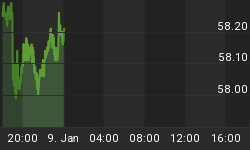Stocks rallied today, as did commodities, in thin year-end trading (I am very tired of this latter phrase, which it seems we could have accurately used since October). The putative reason for the rally was that Initial Claims remained low (364k) rather than bouncing to 380k as the consensus estimate had predicted. The quality of the Initial Claims data will deteriorate rather sharply over the next couple of weeks and for the first few weeks of January, but it does seem likely that we have moved out of the old range of 400k-425k and into a new lower range. This is consonant with a general improvement in the overall data (and in the mood in the country!).
M2 money supply leapt $32bln last week. So much for the possibility I mentioned a few weeks ago that the pace of money growth might be slowing. The 52-week rise in M2 is back up to 9.8%. One of the restraints on inflation, despite this money growth, has been the slower rise in transactional money in Europe, where the year-on-year rate of rise in M2 as of the end of October was only 2.1%. This is soon to change, however, thanks to the ECB's new operation. As a blog post from The Economist pointed out yesterday, ECB President Mario Draghi has stopped the stern denials about the ECB engaging in quantitative easing.
"Each jurisdiction has not only its own rules, but also its own vocabulary. We call them non-standard measures. They are certainly unprecedented. But the reliance on the banking channel falls squarely in our mandate." (The source of the quote is an interview with the Financial Times here, but the Economist article makes for better reading.)
The 'news' of the day being thus dispensed with, I can proceed directly into a belated observation or two about the Fed's Z.1 "Flow of Funds" release that was posted in early December. The Z.1 is a rich source of bauxite with just a little alumina within it, but one does occasionally find something valuable and/or interesting. I like to plot the debt numbers in various ways, because the Fed helpfully slices up the debtors into convenient categories (although they seem to still include Fannie Mae and Freddie Mac debt in "private" domestic financial institutions, which is a ridiculous fiction. More on the impact of that fiction in a moment).
I have published charts with roughly quarterly regularity simply to provide a concrete reminder that the popular story about household deleveraging is largely a myth. The chart below shows it very clearly: most of the deleveraging has come from domestic financial institutions. This will continue, as the Fed moves to implement substantially all of the Basel III recommendations and demands an extra layer of "protection" in the form of capital from systemically important institutions. Households have de-levered somewhat as well, but not really very much in the grand scheme of things. It just feelslike deleveraging compared to the wild leveraging behavior seen prior to 2008. Relative to income, consumers are carrying less debt, and it is the first decline in a generation, true. But it isn't very much.

Businesses are adding debt!
But here's the interesting thing in the chart above. Businesses are re-levering. Okay, technically they are not re-levering, but they are adding debt. This also spears a popular story, that of the cash-hoarding trolls that run businesses in America today. We are told that if businesspeople would only have confidence (those lousy one percenters!) the economy would be healed. Well, it's a wonderful story, except for the fact that 'taint so. Business owners are behaving like Scrooge, all right, but it's Scrooge after the visitation by Marley's ghost.
It is true that there is more cash on corporate balance sheets than there was five years ago. In some cases, it looks as if companies are issuing debt to hold cash! But that may not be far from the truth. After credit lines evaporated in 2008 and 2009, a prudent business will need to keep lots more cash on hand as an insurance measure. It is a good sign that business debt is growing, and it means this measure confirms the recent expansion in commercial bank credit that I mentioned and illustrated in a comment last week.
The second interesting chart is shown below. It computes the total federal, state, and local government debt as a proportion of GDP. The ratio currently stands at 86.6%.

U.S. public debt is approaching 100% of GDP.
That would not be a big story in itself, but the red line is. The red line is the ratio if you simply recognize that Fannie Mae and Freddie Mac debt are de facto obligations of the Federal government. And that ratio is at 96.1%, and will almost certainly exceed the magical 100% level by the middle of next year.
[Of course, you could plausibly argue that if you include Social Security and Medicare obligations, the obligation ratio is wayyyyy over 100%. But there are two differences with those obligations. One is that the government can decide to stop paying those benefits and it would not constitute a default. An abrogation of the social contract, yes; a default, no. The other difference is that Social Security and Medicare are inflation-linked, so the government can't inflate out of them. Therefore, the existence of those obligations shouldn't influence whether or not a calculated decision is made to spur inflation to reduce the real burden of the debt.]
Have a very Merry Christmas, a Happy Hanukkah, or be otherwise jolly no matter what your religious or secular persuasion. There will be one more article before the new year - but not this week!
















